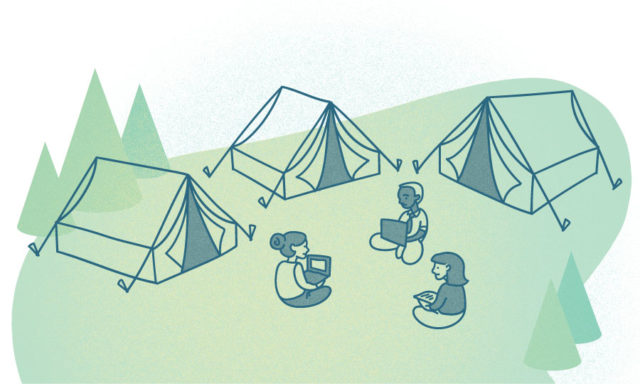Leaders and internal communicators know employees have “change fatigue”. But the ability of workforces to adopt the behaviours that enable strategic pivots to new business models or opportunities is a foremost concern for many organizations. We need to think differently about how we prepare employees for change. A major component of this challenge is the expectation that we are hired to a job, and that the job will remain somewhat consistent.
Today, the sustained pace of transformation in the workplace is very different than at any point in history. As Canadian Prime Minister Justin Trudeau put it at the 2018 World Economic Forum, “The pace of change has never been this fast, yet it will never be this slow again.” The contemporary workplace has fostered a sense of exhaustion and dislocation by enabling too-rigid expectations of roles as it contends with globalization, automation and the shift to digital and mobile technologies.
With the impending impacts of sophisticated artificial intelligence, biotechnology and nanotechnology, climate change and rising political instability, it is safe to assume that the rapid pace of change in organizations will only increase in the years to come. None of us should expect our roles to remain consistent.
We need to structure our organizational cultures for change and sustain high-levels of resilience and flexibility among employees.
The crisis of expectation and identity
Progress is a type of change, and it is experienced as invigorating and motivating. What is it about workplace change that inclines employees toward negative perceptions and feelings of exhaustion?
Work is an important facet of identity and where we work is essential to our sense of the sociological “tribe” to which we belong. If we work for a bank, we are surrounded by other bankers and are part of a network of people shaped by the values and practices of banking. Individuals take recognition and validation for themselves from their environment. To the extent that the environment is populated by bankers, they will construct an image of themselves relative to that context: as bankers, who are competent in a given set of behaviours.
When change diminishes the importance of certain skills or eliminates valued interactions, individuals feel a sense of loss – of validating moments and competency. When that change is exerted from the outside – whether it is job loss from market conditions or a new direction chosen by executives – the sense of personal agency is subverted and identity undermined. As a result, change is experienced as stressful and negative.
The positive experience of change as progress is characterized by a different awareness – that one’s performance is improving in some dimension, and that the individual made meaningful choices toward that accomplishment. Some of this can be accomplished procedurally, by involving employees in the work that refines or redefines their positions.
More importantly, though, is connecting employees with a different sense of who they are in the workplace. As internal communicators, we need to position what we do in our companies and the ways we do it so that employees feel their identities validated and affirmed by a different set of signals and interactions than they traditionally rely upon.

Change as a way of life is as old as humanity
The expectation that our jobs will remain the same is a form of sedentarism. But we have not always been sedentary. There have been thousands of years of nomadic human existence in societies whose environment was subject to constant change as they pursued food, grounds for livestock grazing, shelter, water or income. They were structured with fluid practices to fit the season and geography and learned to thrive with change.
The “sedentary life/business model” and the organizations that practice them no longer fit our reality. Every workforce must become nomadic, moving with the conditions to fulfill its organization’s purpose.
Nomadic cultures possess seven common characteristics that can inform how we build resiliency, fluidity and strength in contemporary organizations.
1. COMMUNITY SIZE
Nomads. The population sizes of nomadic groups are typically small, usually not more than a few thousand. Even Genghis Khan’s Mongol Empire was a federation of the many different peoples of the Steppes, with distinct lineages and histories united by relationships, leadership and purpose. Social cohesion is reinforced through practices such as intermarriage, gift-giving, child-trading/rearing and shared ritual actions to demonstrate mutual respect and kinship.
Contemporary application. Keep teams and function areas to an intimate size to enable relationships, interactions and meetings that feel personally meaningful. Strengthen bonds between social groups by profiling teams to each other and promoting the use of multi-functional workgroups, secondments and job shadowing. Create touchpoints and communication channels – particularly internal social media accessible through mobile devices – that reinforce a sustained sense of membership and participation in the broader organizational “federation”.
2. LOCAL CULTURE
Nomads. Even when operating within a larger culture, nomadic groups have their own distinct subcultures which include languages and dialects, dress, marriage and culture ceremonies and practices to mark birth and death.
Contemporary application. Foster the identities and internal cohesion of the sub-communities within our organizations. Promote healthy subcultures with colocalization, local leadership, small-group gatherings and events both focused on the business and for social connection. Recognize these groups and cultures in communications to reaffirm their identities and pride but ensure this is happening in a way which minimizes out-groupings and silos, particularly by emphasizing the way they uniquely contribute to a shared purpose.
3. VALUES
Nomads. When the environment is constantly changing, nomadic cultures create a sense of solid ground and continuity with a strong, traditional way of living. Customs and values are practiced and transmitted from generation to generation.
Contemporary application. Instill a strong sense of the values of the organization. Keep them alive by using them to make decisions and by referring to them when discussing the progress or challenges the company is facing.
4. PURPOSE
Nomads. Cultures, in general, have an understanding of themselves as a people who practice life in a specific way, framing the collective meaning of existence. This is particularly true of nomadic groups, and their stories centre them in the world and make sense of the rhythms of their days.
Contemporary application. More than ever, it is necessary to connect employees with the purpose of the organization, and shift focus from the details of the job. When the structure of a role is constantly changing, it is far easier to reinforce identity by having employees focused on fulfilling a purpose in the best way possible rather than doing a specific type of work.
5. STRICT SOCIAL NORMS
Nomads. To maintain social cohesion, nomadic groups have well-defined and distinct social norms; violating these norms is often met with strict punishment.
Contemporary application. Define the culture of the organization, onboard employees to it and reinforce it through communication and action. This clarifies expectations and reinforces the sense of membership and belonging to a distinct group. Leaders within the organization must be seen to be living according to the values and norms. Hiring for cultural “fit” is essential which recommends having a comprehensive employer brand strategy.
6. EGALITARIAN
Nomads. People living nomadically tend to have relatively non-hierarchical social organization. With smaller population size and flatter power hierarchies, every member of the community is in closer, more frequent contact with the senior leaders of the group and are more likely to be heard and represented.
Contemporary application. We know that contact and interaction with senior leaders is powerfully motivating and reinforcing of membership and purpose, and that we need to increase their visibility to employees. Many organizations have already begun flattening their structure or moving higher levels of autonomy to the front line of the company. We need to use communication moments and technologies to facilitate these kinds of interactions – more frequent and less formal. Information and coordination should move throughout the organization rather than adhering to a command-and-control architecture.
7. MUTUAL EXCHANGE
Nomads. These societies are often characterized by the absence of ownership which is a legacy of having common agricultural or ancestral property. This results in a high degree of sharing throughout the culture.
Contemporary application. Without getting into broader societal questions regarding late-stage capitalism, organizations can obviously benefit from a strong culture of shared knowledge and resources. Opening silos and diminishing territorialism is recommended for increasing levels of innovation in the organization. Communications must tell the stories of how people come together to overcome challenges and create new approaches and opportunities through collaboration.
Back to the future
It is encouraging to recognize that we are not approaching a breaking point. Despite the challenges posed by the fluidity of the emerging global economy, we can see there are forms of cultural organization that enable people to enjoy their lives within a shifting landscape. We are already seeing forms of nomadic cultural practice (e.g. flat organizations, cross-functional teams, focus on culture) re-emerge in response to the pressures of the workplace. With the intention of gearing organizations to be economically nomadic, we can confidently and deliberately learn from societies that thrived for hundreds of years through times of continuous change.







